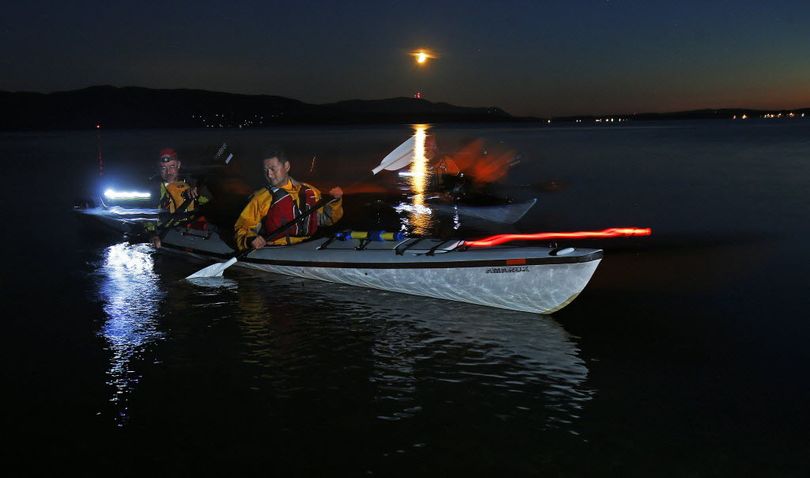Sea kayakers paddle at night where the plankton shines

PADDLING -- Sea kayak outfitters are leading paddlers out of the San Juan Islands as well as Bellingham Bay on night-time excursions to see one of the bright little wonders of the sea.
When conditions are right, the stroke of a paddle paints a swath of bioluminescent light that resembles a swish of Tinkerbell's wand.
"When we accidentally paddled over a school of startled juvenile herring, they jumped out of the water looking like kamikaze lightning bugs," writes Tan Vinh in a story for The Seattle Times.
The natural spectacle of bioluminescence is caused by single-celled planktons that emit light.
Outfitters offering bioluminescent night tours include:
• Community Boating Center in Bellingham will hold its next tours on Sept 5 and 6. $50 per person. 360-714-8891 orboatingcenter.org.
• Salmon Bay Paddle in Ballard leads stand-up paddleboard tours at Shilshole Bay. $85 for one person or $65 per person at group rate. 206-465-7167 or salmonbaypaddle.com.
• Discovery Sea Kayaks in Friday Harbor, San Juan Island, does tours around Griffin Bay. $99 per person. 866-461-2559 or discoveryseakayak.com.
Read on for Vinh's first-person experience.
If you are lucky, these tiny organisms can put on an underwater fireworks show.
“On good nights, when there’s a lot of bioluminescence, they look like little shooting stars underwater,” said Ted Wang, who leads tours every summer. “When I was by Cypress Island, I felt you could read a book it was so bright. We had otters swimming under our boat. When they swim, they disturb the plankton and the plankton start lighting up. You could see the outline of the animals swimming underneath you. They looked like ghosts.”
The Salish Sea is prime territory to see these microscopic plankton or dinoflagellates emit light, a chemical reaction that serves as their defense mechanism when disturbed.
They’re especially visible off the coasts of Florida and California, and here, around Blake Island and the San Juan Islands, among other areas in Washington. They flash brightest from mid-July to mid-September, local experts say.
“Every time I’ve gone out in August, it’s glowing,” said University of Washington biologist Claudia Mills, who works at UW’s Friday Harbor Laboratories and kayaks around the San Juan Islands three nights a week.
“I have a kayak with foot pedals that’s like an egg beater,” said Mills. When the small organisms create these blue sparkles, “there’s all this glitter underneath my boat. Sometimes we see salmon. They are outlined in blue. You see a streak of fish outlined, moving under you.”
To catch this natural spectacle you need total darkness. The full moon is your worst enemy. The lights from a front porch or other development are bad, too. These glowing plants don’t glow as brightly as they do in the famed Mosquito Bay, in Vieques, Puerto Rico, so you need a natural black screen.
You can dip your toes from a dock or swim to get the light show going. But nothing beats the view from the cockpit of a kayak, in which you can cover a lot of ground and have a front-row seat.
Guides are good
It’s best to be familiar with the waters you plan to tour, and to be an experienced kayaker, since you’ll be paddling in the dark. If not, consider going with a tour group or guide since you will be safer in choppy waters, far from urban lights and signs of civilization.
Tours are offered to see bioluminescence around Friday Harbor, Bellingham Bay and Seattle’s Shilshole Bay.
As with fishing or whale watching, some nights are better than others. You aren’t guaranteed these plants will light up like a Christmas tree.
On a late July night, I paddled with two old hands at this game, Wang and Kelly Patrick, kayak instructors who lead bioluminescence tours every summer for the Community Boating Center in Bellingham. We kayaked around the Port of Bellingham, then along a bank where I heard the crackle of bonfires off Post Point. On any other trip, the glow of bonfires under the dark sky would be a welcome, soothing backdrop. But for this trip, we needed to paddle away from that light. Wang guided us under a railroad bridge, around the corner to a shallow bay that’s usually impassible except at high tide.
We started to see flickering light.
“Put your hand in the water and shake,” Wang said.
I could see the outline of my hand glowing. Every time I plopped my hand in the water, it was like dropping an Alka-Seltzer tablet — little glowing bubbles.
It’s like an underwater, interactive artwork installation. I fanned my fingers out then made a fist and it mimicked a jellyfish. I spun the paddle and it was like stirring a glass of soda water with a straw.
“It’s like bottle rockets with trails of sparks,” Wang said.
Or at least that’s what I think he said. I couldn’t quite hear him because I was busy splashing the water.
